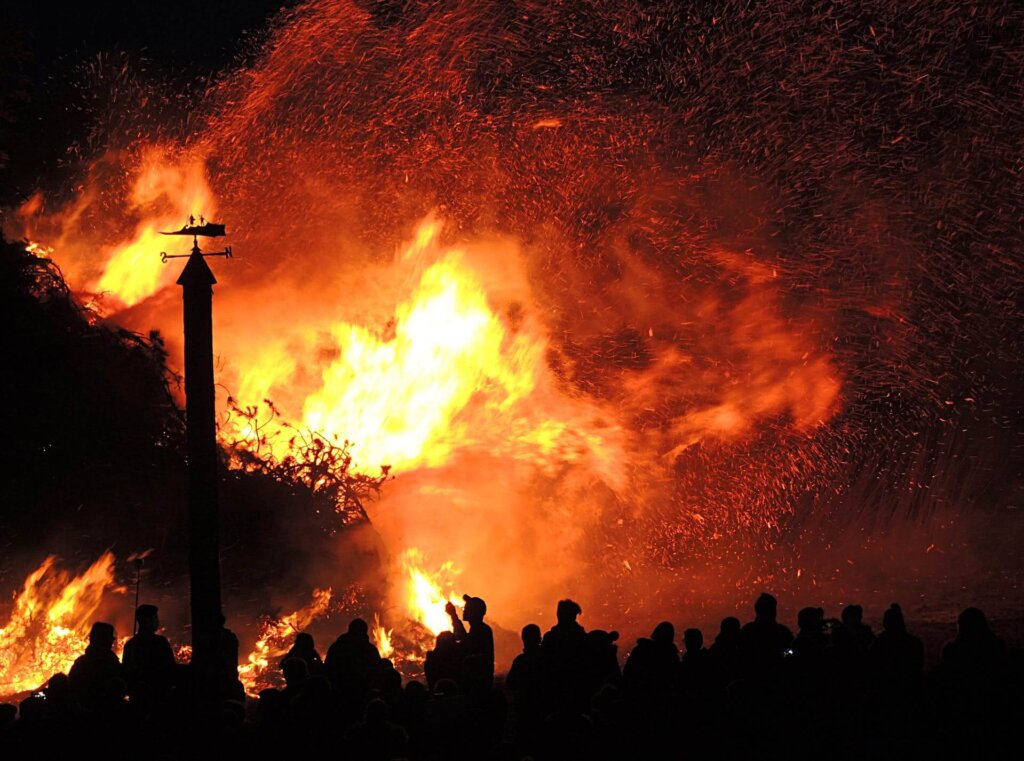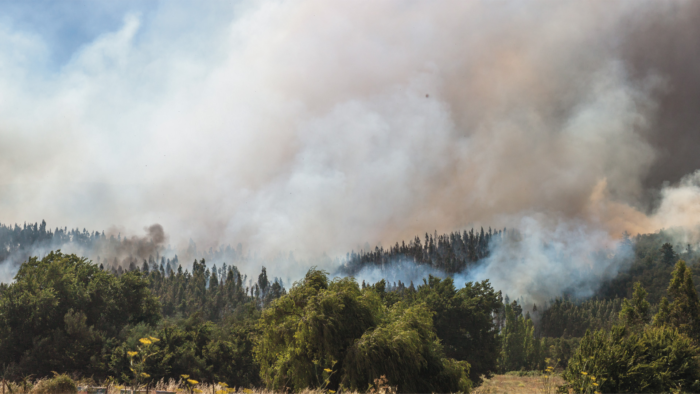Thousands of wildfires burn across vast areas of the United States every year, though not all make it to the news. Some are relatively small and easy to contain. Others emerge in remote and unpopulated areas where they don’t pose a significant threat to human life. Then there are those fires that are so big and destructive that they are not only widely reported at the time but go down in history and are still remembered decades later. In some cases, even over a century later. Names such as the Great Chicago Fire or the Thumb Fire are etched in the public’s consciousness and easily recognizable even today.
While forest and wildland fires are often seen as a relatively modern problem, the list of the largest wildfires in US history includes both recent and historic wildfire events. Below you’ll find our list of some of the most devastating fires recorded in the last two centuries.
Table of Contents
Toggle9 Largest Wildfires in US History
Dixie Fire (California) – 963,309 Acres Burned
- Date: July 2021 – October 2021
- Location: Plumas, Shasta, Lassen, Tehama, and Butte County in California
The Dixie Fire was not only the largest fire in California in 2021 but in all of California’s recorded history. The fire started with a tree falling onto a power line and was active for 104 days between July 13 and October 25. During that time, the Dixie Fire burned 963,309 acres of land, damaging or destroying over 1,300 residential and commercial structures and killing one person.
Thumb Fire (Michigan) – over 1 Million Acres Burned
- Date: September 1881
- Location: Tuscola, Huron, Sanilac, Lapeer, and St. Clair counties in the Thumb region of Michigan
The Thumb Fire started on September 4, 1881, and continued until September 6, 1881, but even though it only lasted a few days, it’s undeniably one of the largest wildfires in US history. The fire destroyed over 3,000 structures, left thousands of people homeless, and burned an area of more than one million acres, with the death toll reaching 282 people and the damage estimate exceeding $2,347,000 (in 1881 dollars).
August Complex Fire (California) – over 1,032,600 Acres Burned
- Date: August 2020 – November 2020
- Location: Mendocino, Humboldt, Trinity, Tehama, Glenn, Lake, and Colusa County in Northern California
The August Complex fire began on August 16, 2020, with multiple separate fires started by lightning strikes and was active for 87 days until it was eventually contained on November 11, 2020. With over a million acres burned, it’s one of the biggest wildfires recorded in the US and the biggest fire complex in California. Despite its size, the remote location of the fires limited the death toll and damage to communities. However, the blaze still destroyed more than 900 buildings and killed one firefighter.
Peshtigo Fire (Wisconsin) – 1.2 to 1.5 Million Acres Burned
- Date: October 1871
- Location: Northeastern Wisconsin
Two large fires started on October 8, 1871: the Great Chicago Fire and the Peshtigo Fire. The damage estimate for both disasters is similar, with $169 million worth of damage caused by the Peshtigo Fire and $200 million by the Chicago Fire. Despite this, the Peshtigo Fire is not as well-known today as the fire that destroyed Chicago, although it has its own place in history as the deadliest wildfire in the US. It’s estimated that at least 1,200 lives were lost due to the blaze, though the exact death toll is difficult to calculate. The memory of this disaster is kept alive by the Peshtigo Fire Museum in Peshtigo, Wisconsin.
Taylor Complex Fire (Alaska) – 1,305,592 Acres Burned
- Date: 2004
- Location: Alaska
With over 1.3 million acres burned, the Taylor Complex Fire was the biggest fire during the 2004 Alaska wildfire season, which burned over 6 million acres in total. At the time, the Taylor Complex fire was the largest one in US history.
Great Michigan Fire (Michigan) – 2.5 Million Acres Burned
- Date: October 1871
- Location: Michigan (Holland, Manistee, and Port Huron)
On the same day the Chicago and Peshtigo Fires began, a series of smaller forest fires started across Michigan, including the Port Huron Fire, Manistee Fire, and Holland Fire. It’s generally assumed that all of these wildfires were fueled by the same strong winds, which accelerated their spread. Because they took place simultaneously and in close proximity, they are known today collectively as the Great Michigan Fire.
The Great Fire of 1910 (Idaho, Montana, Washington) – 3 Million Acres Burned
- Date: August 20-21, 1910
- Location: North Idaho, Western Montana, Eastern Washington, and Southeast British Columbia
Over two days and nights, flames consumed more than 3 million acres of land, making the Great Fire one of the worst wildfires in the history of the United States. The blaze reached its full force after strong winds combined several smaller fires into one large fire, killing 87 people and burning buildings, towns, and forests.
2011 Texas Wildfires – 4 Million Acres Burned
- Date: 2011
- Location: Texas
The 2011 Texas wildfire season was one of the worst in history, with more than 31,000 fires burning over 4 million acres of land and destroying almost 3,000 homes. The biggest fire of the season (and in Texas history) was the Bastrop County Complex fire, which started on September 4, spreading over 32,000 acres and killing two people. The damage estimate exceeded $325 million.
2020 California Wildfires – 4,304,379 Acres Burned
- Date: 2020
- Location: California
The 2020 fire season in California broke all records with over 4.3 million acres burned, 33 deaths, over 11,000 destroyed structures, and more than $10 billion worth of damage. In total, there were 8,648 in California during this fire season, and the August Complex fire was the biggest and most destructive one of them.
Wildfires Are Becoming More Dangerous and Frequent Around the World
If we look at the history of wildfires globally, we’ll find many examples of even more destructive disasters in different parts of the world. The largest wildfires include:
- 2014 Northwest Territories fires in Canada – 8.6 million acres burned
- 1919/2020 Australian Bushfires – 42 million acres burned
- 2003 Siberian Taiga Fires in Russia – 55 million acres burned
Of course, every wildfire, no matter how small or big, can damage ecosystems and property and result in the loss of human life. However, the images and sheer size of the largest wildfire events tend to make the biggest impression and serve as a constant reminder of the consequences of climate change.
Along with rising temperatures, climate change brings longer and more frequent heatwaves, droughts, and drier conditions that can not only exacerbate typical wildfire seasons but lead to wildland and forest fires in areas where they were rare or practically unheard of in the past.
The 2023 wildfire season in Canada, with over 45 million acres burned across all provinces, is now considered the largest wildfire in recorded history of Northern America. And this is just one example of record-breaking fires in recent years. Judging by global wildfire activity, the biggest wildfire in history may very well be waiting for us somewhere in the future.
Early Wildfire Detection Systems Can Limit Fire-Related Risks
Even though wildfires cannot be predicted or prevented with 100% accuracy, every year and every forest fire provides valuable information. With a better understanding of wildfires’ different risks and stages, it’s possible to develop new and more effective methods and tools to prevent and contain fires.
Nowadays, new technologies enable 24/7 monitoring of at-risk areas, even in remote or hard-to-reach locations. Our SmokeD automatic wildfire detection system equipped with sensitive cameras can spot early signs of fire, such as flames and smoke, and send automatic alerts to notify users of any potential threat in the area and its location. Because the system uses artificial intelligence and machine learning algorithms to analyze the collected images, it continues to evolve over time and learn to recognize different patterns to provide even more reliable results.
If you’d like to learn more about our detection system, please feel free to contact us. We’ll be happy to answer any of your questions and help you find solutions best suited to your needs.



